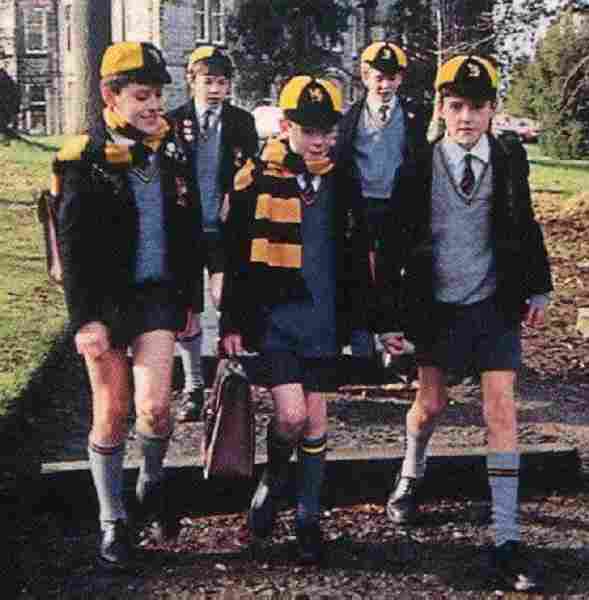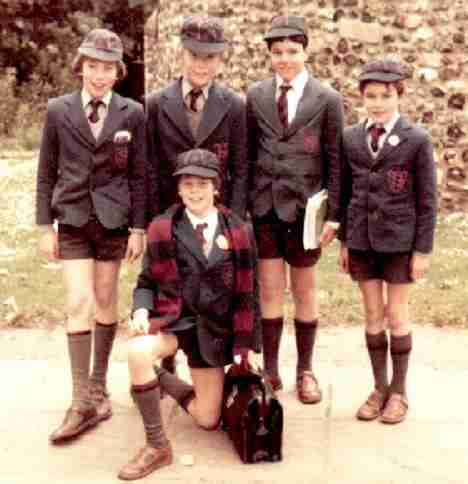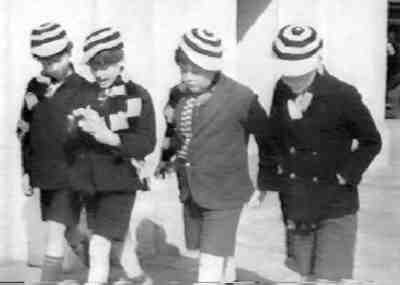
Figure 1.--Some of these Irish school boys are wearing their school scarves. Also notice the caps and bookbags. This photograph appears to have been taken in the 1970s or early 1980s.


Figure 1.--Some of these Irish school boys are wearing their school scarves. Also notice the caps and bookbags. This photograph appears to have been taken in the 1970s or early 1980s. |
Private schoolboys often wore scarves during the winter. The scarves would be in colors matching their uniforms.
The most common type of scarve was quite long so it could be wrapped secuely around the neck. It usually had alternating horizontal bands in two colors. There was a fringe on both ends. This style has proved so popular that many scarves for general sale has been produced styled like these scarves.
Not all school scarves had 'tassels' on the ends,
the majority I would say had plain ends. Also, many had the colours running 'lengthwise' on the scarf, rather than across them.
School scarves have been worn in varius countries, but are most associated with England.

Figure 2.--Some English prep and public school boys liked to wear their scarves even when it wasn't very chilly out. |
Interestingly, scarves were not uncommonly worn with just a blazer and not always with an overcoat. A British source indicated that one could keep quite warm in just a blazer when a scarve was worn. Another source indicates that this was just boys at a posh private school flaunting their preceived status. I believ school scarves are still worn, but have current information.
Scarves are not restricted to private schools by any stretch of the imagination! Whether or not it is a follow on from private schools, HBC cannot substantiate. However it is likely that the school scarve is another garment originating in the English public scool. Many colleges and universities eventually adopted their own scarves, of course in the school colors. A great many state secondary schools in England still have their own uniform scarves, but overall the number of pupils that wear them in Engkand has dropped dramatically.
Scarves were worn at state schools, but the practice varied greatly from school to school.
An English contributor to HBC notes, "When I was at school, if you wore a scarf it had to be the school one, and no other. Anyone found wearing a non-school scarf was dealt with appropriately." Not so these days, or very rarely. Pupils at most schools can wear any scarf (obviously within reason!!), but some still do stick to the old rigid traditions.

Figure 3.--Perhaps the most famous English school scarves were the ones worn by William and the Outlaws. |
Another English contributor confirms that many English schools were once quite strict about the scarves worn with the school uniform. He indicates that, "At my grammar school in the 1960s there was an official scarf but some boys flouted the rule and wore non-regulation scarves. A particular master, who was obsessed with rules, took to lurking at the school gates in order to catch pupils who were wearing 'illegal' scarves. I was one of the boys found contravening the rule and I can recall considering the whole matter ridiculous and petty. Rather than ask my parents to purchase the expensive school scarf, I went without one that winter."
Other English contributors report very different conventions at their schools. He reports that where he lived, it was not only elite private schools that had scarves as part of the uniform. "My Yorkshire grammar school in the 1960s had a striped scarf
available in the school colours, but it was optional, not compulsory, and I
never had one myself. I think in my family we thought the idea of wearing a
scarf slightly sissy or "wimpy" as one would say today--in those days when
it was cold outside one was supposed just to press hardily on and ignore it.
I don't remember that very many of my schoolmates had scarves either, and
those that did were probably regarded by the rest of us as having been
"mollycoddled" by their mothers."
One amusing aspect of scarves was that some parents took the uniform list literally, and took the stance that if it was on the list, it had to be bought. This then gave the spectacle of lads on the first few days at their new school arriving wearing scarves as part of their uniform. Yes, the weather in the UK is a bit naff compared with other parts of the world, but rarely (never???) do you need to wear scarves in September. With everything else being worn, lads soon got rather hot and so these items quickly disappeared until they were more appropriately needed!
The practice of wearing a striped scarf over the top of a jacket or blazer
(never tucked in), without an overcoat, even in the summer, really comes
from the English university tradition, where the scarf in your college's
colours is as much a badge of identity as an article of clothing. It's a
bit old-fashioned now but you can still see this being done in places like
Oxford and Cambridge. (Mind you, Cambridge is a cold windy place even in
the summer, so it does not seem particularly inappropriate there.)
In general, my impression is that young people now do not wear scarves much.
It does not really fit in with today's casual look. An Englishman living in Belgium reports to HBC, "I have a striped scarf (from a college I didn't actually attend!) which I sometimes wear in winter here in Belgium, partly because I like the colours but mainly to keep my
neck warm, and I have no doubt it makes me instantly recognisable as an
Englishman, because continentals only ever wear scarves in single solid
colours, if at all."
No information on scarves in other countries is available at this time.
Related Chronolgy Pages in the Boys' Historical Web Site
[The 1880s/a>]
[The 1930s]
[The 1940s]
[The 1930s]
[The 1940s]
[The 1950s]
[The 1960s]
[The 1970s]
[The 1980s]
Related Style Pages in the Boys' Historical Web Site
[Long pants suits]
[Short pants suits]
[Socks]
[Eton suits]
[Jacket and trousers]
[Blazer]
[School sandals]
Navigate the Boys' Historical Clothing Web Page
[Return to Main school uniform page]
[Return to Main school uniform garment]
[Introduction]
[Chronology]
[Clothing styles]
[Biographies]
[Bibliographies
[Activities]
[Countries
[Contributions]
[Boys' Clothing Home]
